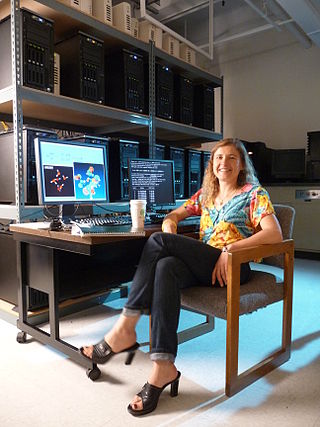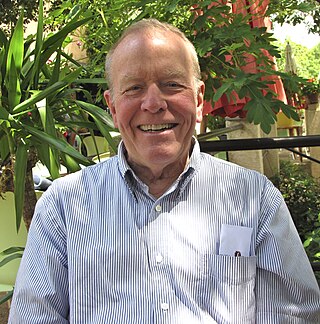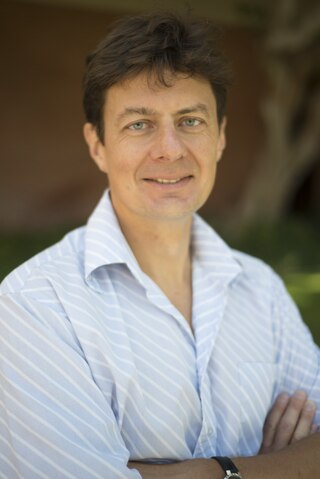
In chemistry, a hydrogen bond is primarily an electrostatic force of attraction between a hydrogen (H) atom which is covalently bonded to a more electronegative "donor" atom or group (Dn), and another electronegative atom bearing a lone pair of electrons—the hydrogen bond acceptor (Ac). Such an interacting system is generally denoted Dn−H···Ac, where the solid line denotes a polar covalent bond, and the dotted or dashed line indicates the hydrogen bond. The most frequent donor and acceptor atoms are the period 2 elements nitrogen (N), oxygen (O), and fluorine (F).
Diarylethene is the general name of a class of chemical compounds that have aromatic functional groups bonded to each end of a carbon–carbon double bond. The simplest example is stilbene, which has two geometric isomers, E and Z.
In chemical kinetics, a reaction rate constant or reaction rate coefficient is a proportionality constant which quantifies the rate and direction of a chemical reaction by relating it with the concentration of reactants.
In chemistry, heterolysis or heterolytic fission is the process of cleaving/breaking a covalent bond where one previously bonded species takes both original bonding electrons from the other species. During heterolytic bond cleavage of a neutral molecule, a cation and an anion will be generated. Most commonly the more electronegative atom keeps the pair of electrons becoming anionic while the more electropositive atom becomes cationic.
In chemistry, molecularity is the number of molecules that come together to react in an elementary (single-step) reaction and is equal to the sum of stoichiometric coefficients of reactants in the elementary reaction with effective collision and correct orientation. Depending on how many molecules come together, a reaction can be unimolecular, bimolecular or even trimolecular.
In chemistry and molecular physics, fluxionalmolecules are molecules that undergo dynamics such that some or all of their atoms interchange between symmetry-equivalent positions. Because virtually all molecules are fluxional in some respects, e.g. bond rotations in most organic compounds, the term fluxional depends on the context and the method used to assess the dynamics. Often, a molecule is considered fluxional if its spectroscopic signature exhibits line-broadening due to chemical exchange. In some cases, where the rates are slow, fluxionality is not detected spectroscopically, but by isotopic labeling and other methods.

Anna Igorevna Krylov is the USC Associates Chair in Natural Sciences and Professor of Chemistry at the University of Southern California (USC). Working in the field of theoretical and computational quantum chemistry, she is the inventor of the spin-flip method. Krylov is the president of Q-Chem, Inc. and an elected member of the International Academy of Quantum Molecular Science, the Academia Europaea, and the American Academy of Sciences and Letters.

Arieh Warshel is an Israeli-American biochemist and biophysicist. He is a pioneer in computational studies on functional properties of biological molecules, Distinguished Professor of Chemistry and Biochemistry, and holds the Dana and David Dornsife Chair in Chemistry at the University of Southern California. He received the 2013 Nobel Prize in Chemistry, together with Michael Levitt and Martin Karplus for "the development of multiscale models for complex chemical systems".

Beryllium hydride is an inorganic compound with the chemical formula n. This alkaline earth hydride is a colourless solid that is insoluble in solvents that do not decompose it. Unlike the ionically bonded hydrides of the heavier Group 2 elements, beryllium hydride is covalently bonded.

Ascalaph Designer is a computer program for general purpose molecular modelling for molecular design and simulations. It provides a graphical environment for the common programs of quantum and classical molecular modelling ORCA, NWChem, Firefly, CP2K and MDynaMix . The molecular mechanics calculations cover model building, energy optimizations and molecular dynamics. Firefly covers a wide range of quantum chemistry methods. Ascalaph Designer is free and open-source software, released under the GNU General Public License, version 2 (GPLv2).
John Isaiah Brauman was an American chemist.

James Bernhard Anderson was an American chemist and physicist. From 1995 to 2014 he was Evan Pugh Professor of Chemistry and Physics at the Pennsylvania State University. He specialized in Quantum Chemistry by Monte Carlo methods, molecular dynamics of reactive collisions, kinetics and mechanisms of gas phase reactions, and rare-event theory.

Liquid-crystals are supramolecular aggregates exhibiting both crystalline (solid) properties as well as amorphous, liquid-like properties.
Millard Henry Alexander is an American theoretical chemist. He is Distinguished University Professor at the University of Maryland, with appointments in the Department of Chemistry and Biochemistry and the Institute for Physical Science and Technology. He is the author of over 300 publications and an active researcher in the fields of molecular collision dynamics and theoretical chemistry.

Oleg V. Prezhdo is a Ukrainian–American physical chemist whose research focuses on non-adiabatic molecular dynamics and time-dependent density functional theory (TDDFT). His research interests range from fundamental aspects of semi-classical and quantum-classical physics to excitation dynamics in condensed matter and biological systems. His research group focuses on the development of new theoretical models and computational tools aimed at understanding chemical reactivity and energy transfer at a molecular level in complex condensed phase environment. Since 2014, he is a professor of chemistry and of physics & astronomy at the University of Southern California.

Martin Quack is a German physical chemist and spectroscopist; he is a professor at ETH Zürich.
Hanna Reisler is an Israeli-American Professor of Chemistry at the University of Southern California. She is interested in the reaction dynamics of molecules and free radicals, as well as the photodissociation in the gas phase. Reisler established the University of Southern California Women In Science and Engineering (WISE) program.
David N. Beratan is an American chemist and physicist, the R.J. Reynolds Professor of Chemistry at Duke University. He has secondary appointments in the departments of Physics and Biochemistry. He is the director of the Center for Synthesizing Quantum Coherence, a NSF Phase I Center for Chemical Innovation.

Frans Carl De Schryver is a Belgian chemist currently serving as Professor Emeritus in the Department of Chemistry of the KU Leuven. Pursuing his interests in polymer synthesis, time and space resolved chemistry, he founded the Laboratory for Photochemistry and Spectroscopy at the KU Leuven. He has co-authored over 650 papers in peer-reviewed journals.

Stephen Kukolich, is an experimental physical chemist in the chemistry and biochemistry department at the University of Arizona. His primary research is high-resolution rotational spectroscopy to determine molecular structures and electronic properties of molecules and molecular complexes. The molecular spectroscopy research was published in 225 papers which were mentioned in 4300 citations (ResearchGate.) and discussed in a few. Details of citations are given by Google Scholar and Academictree. The research was funded by the NSF 11 times beginning in 1970.










